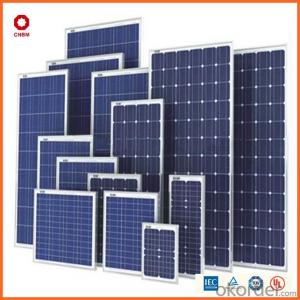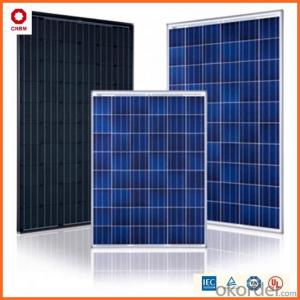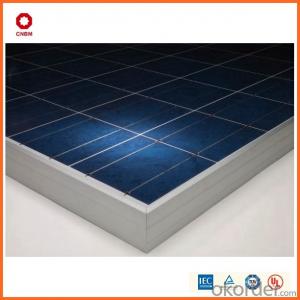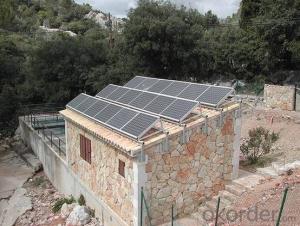25w Small Solar Panels with Good Quality
- Loading Port:
- China main port
- Payment Terms:
- TT OR LC
- Min Order Qty:
- 1 watt
- Supply Capability:
- 10000000 watt/month
OKorder Service Pledge
OKorder Financial Service
You Might Also Like
Item specifice
Product Description:
Hot Sale !!! Quality and Safety of Small Poly Solar Panel 35~85w
1. Rigorous quality control meets the highest international standards.
2. High-transmissivity low-iron tempered glass, strong aluminium frame.
3. Using UV-resistant silicon.
4. IS09001/14001/CE/TUV/UL
Warranties of Small Poly Solar Panel 35~85w
1. 10 years limited product warranty
2. 15 years at 90% of the minimal rated power output
3. 25 years at 80% of the minimal rated power output
Specification
Characteristics of Poly solar panels CNBM (245-320W) | |||||
Max Power Voltage Vmp(V) | 30.3 | 30.8 | 31.1 | 31.4 | 31.85 |
Max Power Current Imp(A) | 7.60 | 7.64 | 7.73 | 7.81 | 7.85 |
Open Circuit Voltage Voc(V) | 36.1 | 36.6 | 37 | 37.3 | 37.68 |
Short Circuit Current Isc(A) | 8.50 | 8.55 | 8.65 | 8.75 | 8.85 |
Max Power Pm(W) | 230W | 235W | 240W | 245W | 250W |
Temperature Coefficient of Cells Poly solar panels CNBM (245-320W) | |
NOCT | 45± 2 |
Temperature Coeffucients of Isc | 0.0492 |
Temperature Coeffucients of Voc | -0.3374 |
Temperature Coeffucients of Voc | -0.4677 |
Mechanical Data of Poly solar panels CNBM (245-320W) | |
Dimension | 1638 × 982 × 40 mm |
Weight | 19.5 kg |
No. of Cells and Connections | 60 (6 ×10) |
Tolerance | 0 ~ + 5 W |
Cell | Monocrystalline Cell 156 × 156 mm |
Packing | 624 Pcs/40ft(H) Container |
Limits of Poly solar panels CNBM (245-320W) | |
Operating Temperature | -40 to +85 |
Storage Temperature | -40 to +85 |
Max System Voltage | 1000VDC(IEC) / 600VDC(UL) |
Features of our products:
• High conversion efficiency mono/poly-crystalline amorphous silicon solar cells
• Modules incorporate high performance bypass diodes to minimize the power drop caused by shading
• High transmittance, low-iron tempered glass
• High performance EVA encapsulant to prevent destroying and water.
• AI frame: without screw, corner connection. 8 holes on the frame can be installed easily
• Good performance of preventing from atrocious weather such as wind and hails
• Certifications: CE IEC TUV VDE UL, Class I
• 10 years 90% power output warranty

Shipping of Small Poly Solar Panel 35~85w
By Sea | Delivery from Shanghai or Ningbo seaport |
By Air | Departure from Shanghai Pudong Airport |
By Express | Post by DHL, EMS, UPS, TNT. |
- Q:Can solar energy systems be used in areas with limited access to sunlight due to shading from nearby buildings or structures?
- Areas with limited access to sunlight due to shading from nearby buildings or structures can still utilize solar energy systems, albeit with potential efficiency implications. It is crucial to evaluate the degree of shading and its impact on the solar panels' electricity generation capabilities. In cases where shading is minimal and temporary, such as when shadows are cast during specific times of the day, solar energy systems can remain feasible. However, if shading persists throughout the day and covers a significant portion of the panels, it can substantially diminish the system's overall energy output. To mitigate the effects of shading, several options are available. One alternative is to optimize the placement of solar panels to maximize exposure to sunlight. This can be achieved by adjusting the panels' tilt angle and orientation or implementing tracking systems that follow the sun's trajectory throughout the day. Another possibility is to employ micro-inverters or power optimizers, which can enhance the output of individual solar panels, even if some are partially shaded. In more extreme shading scenarios, it may be necessary to explore alternative energy solutions or make modifications to nearby structures to minimize shading. This could entail trimming or removing trees, installing reflective surfaces on adjacent buildings to redirect sunlight, or utilizing solar panels on other structures with better access to sunlight. In conclusion, while shading from nearby buildings or structures can reduce the efficiency of solar energy systems, there are still viable options available for areas with limited access to sunlight. It is imperative to assess the specific shading conditions and determine the most suitable solution to maximize energy production.
- Q:How does the efficiency of solar panels vary across different climates?
- The efficiency of solar panels can vary across different climates due to several factors. One of the main factors is the amount of sunlight available in a particular region. Solar panels function by converting sunlight into electricity, so areas with higher levels of sunlight will generally have higher solar panel efficiency. In regions with a hot and sunny climate, such as deserts or tropical areas, solar panels tend to perform better. These areas receive a high intensity of sunlight, providing ample energy for the panels to convert into electricity. As a result, solar panels in these climates can achieve higher efficiency levels. On the other hand, in regions with cooler or cloudier climates, the efficiency of solar panels may be slightly lower. Cloud cover can reduce the amount of sunlight reaching the panels, impacting their overall performance. Additionally, colder temperatures can affect the efficiency of solar panels, as they typically operate more optimally in warmer conditions. However, it is important to note that solar panels are designed to work in various climates and can still generate electricity even in less sunny or colder regions. Advances in technology have enabled the development of solar panels that can absorb sunlight even in low-light conditions, increasing their efficiency in less favorable climates. Moreover, the efficiency of solar panels is not solely determined by climate but also depends on other factors such as the orientation and tilt angle of the panels, shading, and the quality of the solar cells used. Proper installation and maintenance can significantly impact the overall efficiency of solar panels, regardless of the climate. In summary, the efficiency of solar panels can vary across different climates due to factors like sunlight intensity, cloud cover, and temperature. While solar panels tend to perform better in hot and sunny regions, advancements in technology allow them to generate electricity even in less favorable conditions. Proper installation, maintenance, and consideration of other factors also play a crucial role in maximizing the efficiency of solar panels across various climates.
- Q:Can a solar energy system be installed on a hospital or healthcare facility?
- Yes, absolutely. Solar energy systems can be installed on hospitals or healthcare facilities. In fact, many hospitals and healthcare facilities are adopting solar energy as a sustainable and cost-effective solution to meet their energy needs. These systems can provide clean and renewable energy, reducing the facility's carbon footprint and operating costs. Additionally, solar energy installations can help hospitals maintain a reliable power supply during emergencies or power outages, ensuring uninterrupted patient care.
- Q:How do solar energy systems store excess energy?
- Solar energy systems store excess energy through the use of batteries or other energy storage technologies. This allows the surplus energy generated by the system during periods of high sunlight to be stored and used later when sunlight is not available, such as at night or during cloudy days.
- Q:What are the environmental impacts of solar energy systems?
- Solar energy systems have numerous environmental benefits, including reducing greenhouse gas emissions, minimizing air and water pollution, and preserving natural resources. However, the manufacturing and disposal processes of solar panels can generate some waste and require energy inputs. Additionally, land use for large-scale solar installations can impact local ecosystems. Overall, the environmental impacts of solar energy systems are significantly lower compared to conventional energy sources.
- Q:How do solar energy systems impact energy security?
- Solar energy systems can greatly enhance energy security by diversifying the energy mix and reducing dependence on traditional fossil fuels. They provide a decentralized and sustainable source of energy, reducing the vulnerability to disruptions in the supply chain and geopolitical tensions. Furthermore, solar energy systems contribute to grid stability and resilience, as they often include energy storage capabilities.
- Q:How do solar energy systems impact the local community?
- Solar energy systems have a positive impact on the local community in several ways. Firstly, they reduce reliance on fossil fuels, which helps to combat climate change and improve air quality. Solar energy systems also create job opportunities and stimulate economic growth by attracting investments in renewable energy. Moreover, they can lower energy costs for residents and businesses, making electricity more affordable. Lastly, solar power installations contribute to a sense of community pride and environmental stewardship, inspiring others to adopt sustainable practices.
- Q:Can a solar energy system be used to charge electric vehicles?
- Yes, a solar energy system can be used to charge electric vehicles. Solar panels can generate electricity from sunlight, which can then be used to charge the batteries of electric vehicles. This provides a sustainable and renewable source of energy for powering electric vehicles.
- Q:What is the role of batteries in off-grid solar energy systems?
- The role of batteries in off-grid solar energy systems is crucial as they serve as the primary storage devices for the generated solar energy. In off-grid systems, where there is no access to a utility grid, batteries are used to store excess solar energy produced during the day for use during the night or when the sun is not shining. Batteries store the energy in the form of chemical potential energy, which is converted back into electrical energy when needed. This allows for a continuous and reliable power supply, ensuring that electricity is available even when solar panels are not producing energy. Additionally, batteries provide stability and balance to the off-grid solar systems. They act as a buffer, absorbing fluctuations in energy production and demand. For instance, during periods of high energy demand, the batteries can discharge their stored energy to meet the load requirements, preventing any interruptions or power shortages. Furthermore, batteries also play a crucial role in maintaining the longevity and efficiency of the solar panels. By storing excess energy, batteries prevent the solar panels from being stressed by overproduction, which can lead to premature wear and tear or even damage. In conclusion, batteries are an essential component of off-grid solar energy systems as they enable energy storage, provide stability, and ensure a continuous power supply, making them indispensable for reliable and sustainable off-grid electricity generation.
- Q:Can solar energy systems be used for powering electric vehicle charging stations?
- Yes, solar energy systems can be used to power electric vehicle charging stations. Solar panels can be installed to generate electricity from sunlight, which can then be used to charge electric vehicles. This not only provides a renewable and clean energy source for charging stations but also reduces reliance on the electrical grid and helps to mitigate greenhouse gas emissions.
1. Manufacturer Overview |
|
|---|---|
| Location | |
| Year Established | |
| Annual Output Value | |
| Main Markets | |
| Company Certifications | |
2. Manufacturer Certificates |
|
|---|---|
| a) Certification Name | |
| Range | |
| Reference | |
| Validity Period | |
3. Manufacturer Capability |
|
|---|---|
| a)Trade Capacity | |
| Nearest Port | |
| Export Percentage | |
| No.of Employees in Trade Department | |
| Language Spoken: | |
| b)Factory Information | |
| Factory Size: | |
| No. of Production Lines | |
| Contract Manufacturing | |
| Product Price Range | |
Send your message to us
25w Small Solar Panels with Good Quality
- Loading Port:
- China main port
- Payment Terms:
- TT OR LC
- Min Order Qty:
- 1 watt
- Supply Capability:
- 10000000 watt/month
OKorder Service Pledge
OKorder Financial Service
Similar products
New products
Hot products
Hot Searches
Related keywords






























